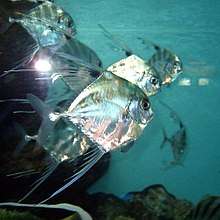Alectis
| Alectis | |
|---|---|
 | |
| juvenile Alectis ciliaris | |
| Scientific classification | |
| Kingdom: | Animalia |
| Phylum: | Chordata |
| Class: | Actinopterygii |
| Order: | Perciformes |
| Family: | Carangidae |
| Genus: | Alectis Rafinesque, 1815 |
| Type species | |
| Gallus virescens Lacepède, 1802 | |
| Species | |
|
See Text | |
| Synonyms | |
Alectis is a genus of fish in the family Carangidae containing three extant species, all of which are large marine fishes. They are commonly known as threadfish, diamond trevallies and occasionally pompanos, although they have no close affiliation with the true pompano genus.
Taxonomy
Alectis is one of 33 genera in the jack and horse mackerel family Carangidae. The Carangidae are perciform fishes in the suborder Percoidei.[2]
The first fish in the genus to be described was Alectis ciliaris under the genus name of Zeus, part of the dory family. Lacépède recognized the species was not a dory and assigned it to a new genus, Gallus, however this was preoccupied by a bird.[3] In 1815, Rafinesque proposed the name Alectis, into which three species were eventually placed. Georges Cuvier proposed a second name, Scyris for the genus in 1829, but Alectis had priority and has therefore been cemented for the time being.[4] The name Alectis is derived from one of three Erinyes in the Greek mythology; daughter of Acheronte with a terrible rage.[5]
A single species has been identified the fossil record, Alectis simus (Stinton, 1979), from the Eocene period of England. It was found alongside a number of extinct and extant carangid genera including Caranx and Usacaranx (extinct).[6]
Species
There are currently three recognized species in this genus:[7]
- Alectis alexandrina (É. Geoffroy Saint-Hilaire, 1817) (Alexandria pompano)
- Alectis ciliaris (Bloch, 1787) (African pompano)
- Alectis indica (Ruppell, 1830) (Indian threadfish)
Biology
The fish of the genus are large, powerful fishes that look very similar to a number of other large jacks, with the main difference being the profile of the head and the characteristic long filamentous anal and dorsal fins displayed by juveniles of these species. They are generally a silver colour, with pale green to hyaline fins. A. indica is the largest of the genus, growing to a reported 165 m and 25 kg in weight.[8]
The genus has a circum-tropical distribution, with adults generally restricted to reefs in coastal areas down to 100 m, while juveniles are often pelagic.[4] All three are predators of small fishes, cephalopods and crustaceans. A little is known of their reproductive habits and larval phases, with spawning occurring during daylight between pairs.[9]
Relationship to humans
The genus is of minor importance to both commercial and subsistence fisheries, with the species generally not numerous enough to warrant a specific fishery.[4] All species are considered fine game fish, attaining large sizes and capable of blistering runs. The flesh of the genus is generally considered very good for culinary purposes, although at least one species has been implicated in a case of Ciguatera poisoning.[10] In Singapore, A. indica has successfully been bred in aquaculture for food production in relatively low numbers. Juveniles are occasionally used in saltwater aquariums, noted for their filamentous anal and dorsal fins.[11]
References
- ↑ Sepkoski, Jack (2002). "A compendium of fossil marine animal genera". Bulletins of American Paleontology. 364: 560. Archived from the original on 2011-07-23. Retrieved 2007-12-31.
- ↑ "Alectis". Integrated Taxonomic Information System. Retrieved 21 October 2007.
- ↑ Hosese, D.F.; Bray, D.J.; Paxton, J.R.; Alen, G.R. (2007). Zoological Catalogue of Australia Vol. 35 (2) Fishes. Sydney: CSIRO. p. 1150. ISBN 978-0-643-09334-8.
- 1 2 3 Carpenter, Kent E.; Niem, Volker H., eds. (2001). FAO species identification guide for fishery purposes. The living marine resources of the Western Central Pacific. Volume 5. Bony fishes part 3 (Menidae to Pomacentridae) (PDF). Rome: FAO. p. 2684. ISBN 92-5-104587-9.
- ↑ Froese, Rainer, and Daniel Pauly, eds. (2007). Species of Alectis in FishBase. October 2007 version.
- ↑ Stinton, F.C. (1979). "Fish Otoliths from the English UK Eocene". Palaeontographical Society Monographs. London. 133 (558): 191–258.
- ↑ Froese, Rainer, and Daniel Pauly, eds. (2013). Species of Alectis in FishBase. February 2013 version.
- ↑ Gunn, John S. (1990). "A revision of selected genera of the family Carangidae (Pisces) from Australian waters". Records of the Australian Museum. Supplement 12: 1–78. doi:10.3853/j.0812-7387.12.1990.92.
- ↑ Westernhagen, H. Von (1974). "Observations on the natural spawning of Alectis indicus (Rüppell) and Caranx ignobilis (Forsk.) (Carangidae)". Journal of Fish Biology. Blackwell Synergy. 6 (4): 513–516. doi:10.1111/j.1095-8649.1974.tb04567.x.
- ↑ Bourdeau, P.; Bagnis, R. (1989). "Risk factors of ciguatera in the French West Indies in Saint-Barthelemy, Saint-Martin and Anguilla (Article in French)". Revue d'élevage et de médecine vétérinaire des pays tropicaux. 42 (3): 393–410.
- ↑ Pet education. "Indian threadfin". Fish. Foster & Smith, Inc. Archived from the original on 2006-03-04. Retrieved 2007-10-23.